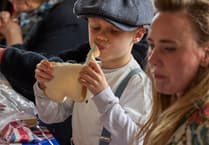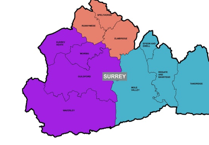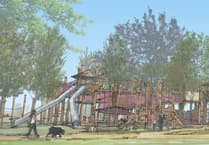The people of Sierra Leone have been through turbulent times over the past 25
years, with a civil war and the outbreak of the Ebola virus in 2013, which killed
between half a million and a million people in west Africa. However, with a return to stability, the future of this west African country is looking brighter, and Greatham architect Ed Dale-Harris is helping a community near the capital Freetown to build its first school. Sheila Checkley spoke to him about his work and love for Africa.
AS a 27-year-old architect in the making, Ed Dale-Harris has quite a contrast of building experience to work with.
Luxury flats in Chelsea and at Tower Bridge alongside an earth-walled school in Sierra Leone, west Africa, being built in stages as soon as the next funding is found.
The We Yone Child Foundation (WYCF) Primary School, in the hills behind Freetown, will offer affordable education, for the first time, to the community serves.
When it is finished it will have places for 360 pupils, ranging from children age five to teenagers, and Ed and his team have already received more than 300 applications.
“Children queue up to go to school and, so far, the children of the village have either been home schooled or had no schooling at all,” Ed said.
Because parents and grandparents rely on children to help look after the animals, fetch water and do the household chores, the school will have morning and afternoon sessions, teaching 180 children per session.
Having two sessions, the pupils can choose which to attend, giving them time to spend at home doing chores for their parents.
There is one problem - there is no road leading to the school and, at present, no water or electricity supply; but it is hoped they will be laid on when the building is complete.
At present, Ed gets to the school “by hopping on a motorbike to get me up the hillside”. “Although we don’t have a road, our pupils will have no problem walking to school as they live nearby,” he added.
The school is not the only project Ed, who grew up in Greatham and went to the village primary school, has been able to use his expertise for.
He has also worked with the Nema Foundation, a Mozambique NGO and charity, on the building of a rural hospital in the east African country.
And he has overseen the building of a house for a victim of the genocide in Rwanda in the summer of 1994. During this horrific bloodbath, members of the Hutu and Tutsi tribes massacred each other, with between half a million and a million Rwandans killed in just four months.
“The house was built for a man as compensation for his brother being killed during the war between the two tribes,” Ed said.
“He lost everything - family members, his house, his cattle - and the killers were jailed for 20 years.
“But when released, the culprits volunteered to build houses for those they had wronged.”
An estimated 50,000 people died in Sierra Leone’s 11-year civil war, from 1991 to 2002, which began when the Revolutionary United Front, with support from the special forces of Charles Taylor’s National Patriotic Front of Liberia, intervened in Sierra Leone in an attempt to overthrow the Joseph Momoh government.
Following the horror of its civil war, the region of Sierra Leone in which Ed works was almost wiped out by the Ebola virus (named after the River Congo in the Democratic Republic of Congo, formerly Zaire).
“In the community where I am working about 100 people died from Ebola,” he said.
The most widespread epidemic of Ebola in history occurred between 2013 and 2015 in Sierra Leone, Liberia and Guinea. This year, although the epidemic is no longer out of control, flare ups of the disease continue, including in Sierra Leone.
Between 2013 and 2016, the World Health Organization suspected at least 11,325 deaths from the outbreak.
However, Sierra Leone, once a dangerous region of Africa, is now at peace; and gradually the government and charities like WYCF, with whom Ed and his team are involved, are trying to bring the basic human rights of education and health to its people.
To help with his work, Ed has set up his own volunteer design group SAWA (Socially Active Workshop Architecture) and they are using sustainable materials, including the rich earth and timber.
Earth buildings like Ed’s, can be as tall as 10 stories. For example, Yemen, on the Arabian Peninsula, is known as “mud Manhattan”.
Earth walls are erected on concrete foundations but, with his passion for sustainable-material techniques, Ed is trying to stop walls being covered in concrete so the earth can breath.
He uses a machine called a “rammed-earth block machine” - a “mega tool” - for speeding up the building work.
Local hardwoods is also used in the building, and a strong corrugated-metal roof will protect the school from the deluge of the monsoon season and keep it cool from the searing heat of the sun. Building the school is also providing employment for local people.
“For example, women will collect water from the nearby stream and carry it on their heads to our site, and, for that, they will get around 10p each time,” Ed said. The small amount she earns will go a long way towards providing food for the family in a region that, at present, has a high teenage-pregnancy rate and, as a result, a lot of single mothers.
“Once a girl gets pregnant in our region she will find it very hard to find a husband and so will have little or no income,” Ed explained. “The government is trying to do something about it and there are notices all over Freetown, the capital, and villages warning young, unmarried girls not to get pregnant.”
Ed has just returned to Africa where, as project manager and lead designer, he is supervising the next stage of the building of the school which, when finished, will have: six classrooms, two offices and four kiosk-style shops to be rented to traders, with the money used to help run the school.
Ed’s work there is in sharp contrast to his day job in England, where he works for a firm of top London architects and, at present, is involved in creating luxury apartments at Chelsea Barracks and at Tower Bridge, working with 21st-century materials like steel and glass and not a mud wall in sight.
On his recent trip to England to be at his brother’s wedding, Ed took time last month to volunteer with the restoration of Greatham’s 13th-century Old Church by helping the Society for the Protection of Ancient Buildings, which has been working there, to put turf on top of the ancient walls.
Ed’s mother Anna is a member of the Greatham Old Church Preservation Group, and Ed also gave a talk at L’Abri, his mother’s Greatham manor house, to volunteers from the Society for the Protection of Ancient Buildings, students from L’Abri (an organisation welcoming people from all over the world) and village residents on his work in Sierra Leone.
Ed talked about the work he is doing in west Africa and how vital it is to raise money for the new school.
Now he is back working on the site, hoping there will be funding for the next stage of building.
His love of Africa began when he took a gap year at 18 and it has continued to grow. As a young man with a high-profile job he could be climbing the career ladder and earning a top salary.
But he said: “It is more important that I am doing work that is meaningful to many. The school will give much-needed opportunities to vulnerable children.”
However, he will be back in England for a year in September, after the school project is hopefully completed, to gain his full architecture qualification.
Asked whether he would not be tempted to stay and enjoy the comforts that this country offers, he said: “I will always want to go back to Africa. I love the people and the life there, the beaches the beautiful landscape. I would love to live there for a time.”
• Ed has a MyDonate page and donations can be made through sawarchitecture.
com/support/. Even a small amount might buy a textbook or an extra chair for a much-needed community school.





Comments
This article has no comments yet. Be the first to leave a comment.